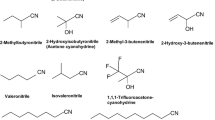Abstract
The activity ofNocardia V. nitro-reductase appears to vary considerably during the life cycle of the culture. The optimal conditions found for the formation of the highest amount of enzyme per unit dry weight of cell were: incubation of the organism in a medium containing salts, glucose, and sodium glutamate at pH 7.4 for 28–30 hr at about 29–30 C. TheNocardia nitro-reductase is a constitutive enzyme in contrast to the adaptive nitrate- and nitrite-reductases in other organisms. The enzyme requires a sulphydryl compound for activity and uses reduced pyridine nucleotides as the electron donor for the reduction of nitro-groups. The only reduction product found when usingp-dinitrobenzene as substrate of the nitro-reductase isp-nitroaniline. This compound has been identified by electrophoresis, spectroscopy, melting point, chemical derivatives and elementary analysis. No evidence has been obtained which indicates the nature of the intermediate steps in the biological reduction of nitro-groups.
Similar content being viewed by others
References
Asnis, R. E. andBrodie, A. F. 1953. A glycerol dehydrogenase fromEscherichia coli. J. Biol. Chem.203: 153–159.
Bauer, H. andRosenthal, S. M. 1944. 4-Hydroxylaminobenzenesulfonamide, its acetyl derivatives and diazotization reaction. J. Am. Chem. Soc.66: 611–614.
Bratton, A. C. andMarshall, E. K., Jr. 1939. A new coupling component for sulfanilamide determination. J. Biol. Chem.128: 537–550.
Bray, H. G., Thorpe, W. V. andWood, P. B. 1949. The fate of certain organic acids and amides in the rabbit. 6. Nitrobenzoic acids and amides. Biochem. J.44: 39–45.
Bray, H. G., Hybs, Z., James, S. P. andThorpe, W. V. 1953. The metabolism of 2:3:5:6- and 2:3:4:5-tetrachloronitrobenzenes in the rabbit and the reduction of aromatic nitro compounds in the intestine. Biochem. J.53: 266–273.
Bueding, E. andJolliffe, N. 1946. Metabolism of trinitrotoluene (TNT) in vitro. J. Pharmacol.88: 300–312.
Cain, R. B. 1958. The microbial metabolism of nitro-aromatic compounds. J. Gen. Microbiol.19: 1–14.
Cartwright, N. J. andCain, R. B. 1959. Bacterial degradation of the nitrobenzoic acids. Biochem. J.71: 248–261.
Cramer, D. L. 1947. The mode of action of nitrofuran compounds. II. Application of physicochemical methods to the study of action againstStaphylococcus aureus. J. Bacteriol.54: 119–125.
Durham, N. N. 1958. Studies on the metabolism ofp-nitrobenzoic acid. Can. J. Microbiol.4: 141–148.
Egami, F., Ebata, M. andSato, R. 1951. Reduction of chloromycetin by a cell-free bacterial extract and its relation to nitrite reduction. Nature167: 118–119.
Fouts, J. R. andBrodie, B. B. 1957. The enzymic reduction of chloramphenicol,p-nitrobenzoic acid, and other aromatic nitro compounds in mammals. J. Pharmacol. Exp. Therap.119: 197–207.
Gale, E. F. andEpps, H. M. R. 1942. The effect of the pH of the medium during growth on the enzymic activities of bacteria (Escherichia coli andMicrococcus lysodeikticus) and the biological significance of the changes produced. Biochem. J.36: 600–618.
Gale, E. F. 1943. Factors influencing the enzymic activities of bacteria. Bacteriol. Rev.7: 139–173.
Gale, E. F. 1946. The bacterial amino acid decarboxylases. Advan. Enzymol.6: 1–32.
Glazko, A. J., Wolf, L. M. andDill, W. A. 1949. Biochemical studies on chloramphenicol (chloromycetin). I. Colorimetric methods for the determination of chloramphenicol and related nitro compounds. Arch. Biochem.23: 411–418.
Kohl, M. F. F. andFlynn, L. M. 1941. Study of reduction of isomeric nitrobenzoic acids by rats. Proc. Soc. Exp. Biol. Med.47: 470–473.
Lowry, O. H., Rosebrough, N. J., Farr A. L. andRandall, R. J. 1951. Protein measurement with the Folin phenol reagent. J. Biol. Chem.193: 265–275.
Nason, A. 1962. Enzymatic pathways of nitrate, nitrite and hydroxylamine metabolisms. Bacteriol. Rev.26: 16–41.
Otsuka, S. 1961. Studies on nitro-reducing enzymes of swine liver. Properties and cofactor requirements of nitro- and nitroso-reductases. J. Biochem. (Tokyo)50: 85–94.
Parke, D. V. andWilliams, R. T. 1957. The metabolism ofm-dinitro-[14C] benzene in the rabbit. Biochem. J.67: 7P.
Saz, A. K. andSlie, R. B. 1954. Reversal of aureomycin inhibition of bacterial cell-free nitro reductase by manganese. J. Biol. Chem.210: 407–412.
Saz, A. K., Brownell, L. W. andSlie, R. B. 1956. Aureomycin-resistant cell-free nitro reductase from aureomycin-resistantEscherichia coli. J. Bacteriol.71: 421–424.
Villanueva, J. R. 1959. Interference by azide with diazotization procedures used in biological assay systems. Nature184: 549.
Villanueva, J. R. 1960. Characterization of a new isolated strain of Actinomycete identified asNocardia V. Microbiol. Españ.13: 169–186.
Villanueva, J. R. 1962. Attempts to show inhibition of nitro-reductase by aureomycin in cell-free extracts and isolation of an aureomycin resistantNocardia V. Nature193: 95.
Villanueva, J. R. 1963. A nitro reductase enzyme apparently without flavin as prosthetic group. Can. J. Biochem. Physiol.41: 1837–1840.
Villanueva, J. R. 1964. The purification of a nitro-reductase fromNocardia V. J. Biol. Chem.239: 773–776.
Westerfeld, W. W., Richert, D. A. andHiggins, E. S. 1957. The metabolic reduction of organic nitro groups. J. Biol. Chem.227: 379–391.
Yamashina, I., Shikata, S. andEgami, F. 1954. Enzymic reduction of aromatic nitro, nitroso and hydroxyl amino compounds. Bull. Chem. Soc. Japan.27: 42–45.
Zucker, M. andNason, A. 1955. Nitroaryl reductase fromNeurospora crassa.In Methods in Enzymology, Colowick, S. P. and Kaplan, N. O. (Eds.), Vol. II, pp. 406–411. Academic Press, New York.
Author information
Authors and Affiliations
Rights and permissions
About this article
Cite this article
Villanueva, J.R. Nitro-reductase from aNocardia sp.. Antonie van Leeuwenhoek 30, 17–32 (1964). https://doi.org/10.1007/BF02046697
Issue Date:
DOI: https://doi.org/10.1007/BF02046697




